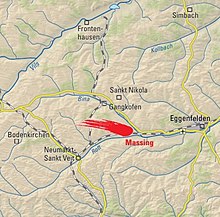Mässing meteorite fall (1803)
| Mässing meteorite fall (1803) | |
|---|---|
| place | Massing |
| Fall time | December 13, 1803 , between 10 a.m. and 11 a.m. |
| Coordinates | 48 ° 23 ′ 0 ″ N , 12 ° 36 ′ 0 ″ E |
| origin | Asteroid Vesta |
| Meteorite name | Mässing |
| collection | Museum of Natural Science |
| authenticity | for sure |
In 1803 it came in Lower Bavaria Massing the decline of a meteorite .
Case report by Ernst Florens Friedrich Chladni
It was probably a cold Tuesday in December when the peasants ran out of their houses, startled by the noise. There is a detailed case report from Chladni . In it he described, among other things, that in the mornings between 10 a.m. and 11 a.m., nine or ten loud cannon shots tore the village silence apart.
“Startled by the noise, the farmer ran out, looked at the sky, saw something that came up very high, with a constant rustling from the air, and finally hit the roof of his wagon hut, killed a few shingles, and penetrated into it. He found a black stone in the hut that smelled of powder and was hot. "
The stone weighed 3¼ pounds. Chladni also reported that he had heard the supposed shots from Altötting , i.e. from the east - but the stone had come from Heiligenstadt (Gangkofen) , i.e. from the west.
Description of the meteorite
The natural scientist Otto Buchner described the appearance of the meteorite as follows:
“The bark is very thin, very black and shiny, almost as if varnished. The ground mass is grayish-white, very fine-grained, fairly loose, similar to pumice porphyry [...], in which spherical and angular inclusions up to the size of a pea of an impure pistachio-green color [...], then cubic black and finally very small translucent grains and leaves of yellowish or olive-green color [... ] are thickly constricted. "
According to recent studies, the meteorite is a member of the rare Howardite group , which is believed to have come from the asteroid Vesta .
Remnants of the meteorite
Hardly any material has survived from the meteorite originally weighing just 1.6 kilograms. The largest preserved piece is in the Museum of Natural History in Berlin . It weighs 22.1 grams and comes from Chladnis' private collection - including the original label. Chladni bequeathed his collection of 41 meteorites to the museum, it is still almost complete. In total, the collection includes meteorites from around 3,500 sites with over 6,000 specimens. Including the Mässinger meteorite. The second largest known piece (16.2 grams) was destroyed in the war in Munich . A 0.24 gram sample of the Mässinger meteorite came into the possession of the Vatican's collection after 1935 from the collection of the Marquis de Mauroy (1848–1927) . And as the custos of the collection, the astronomer Guy Consolmagno SJ, announced, Pope Benedict looked at this envoy from heaven with great interest during his visit to the Vatican observatory in Castel Gandolfo in September 2009.
See also
literature
- Not from this world. Bavaria's meteorite. Bavarian State Office for the Environment , Augsburg 2012, ISBN 978-3-936385-92-2 .

